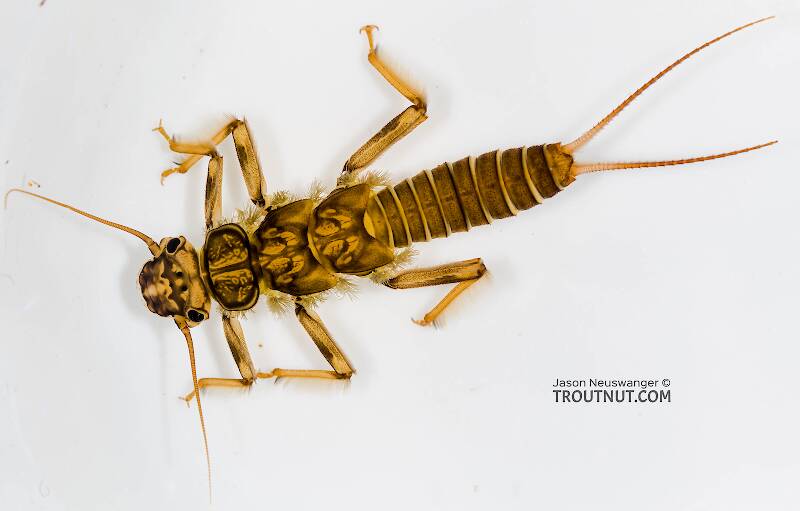
Salmonflies
Pteronarcys californica
The giant Salmonflies of the Western mountains are legendary for their proclivity to elicit consistent dry-fly action and ferocious strikes.

Mayfly Species Eurylophella doris (Chocolate Duns)
Species Range
Physical description
Most physical descriptions on Troutnut are direct or slightly edited quotes from the original scientific sources describing or updating the species, although there may be errors in copying them to this website. Such descriptions aren't always definitive, because species often turn out to be more variable than the original describers observed. In some cases, only a single specimen was described! However, they are useful starting points.
Male Spinner
Wing length: 7.5 mm
A species of the bicolor group (now a synonym of Eurylophella bicolor), close to E. temporalis (now a synonym of Eurylophella temporalis). Imago paler and more yellowish than in the latter species. A distinct concavity of the lateral margin of the pronotum of the nymph seems a distinctive character.
Eyes orange. Base of antenna pale, filament brown. A dark spot below each antenna. Thorax yellowish brown; a few dark dots on the pronotum, and a black submedian spot on each side of the metanotum. Legs pale yellowish; a dark spot on each coxa. Apex of fore tibia, tarsal joinings and claws light reddish brown. Wings hyaline; venation hyaline; a faint brownish tinge at the base of the fore wing in the anal region, and a short dark streak at base of costa and radius. Stigmatic cross veins anastomosed. Abdomen yellowish, paler ventrally. Posterior margins of the basal and middle tergites are brownish red. Distinct dark submedian streaks on tergites 2, 3, and 6-7; faint indications of these on the other tergites. Tracheae dusky; black streaks in the region of the stigma. On tergites 8 and 9, a small black spot is on each side of the median line at the anterior margin; tergite 10 whitish. Basal and middle sternites have the usual curved line of dark dots, which are less apparent apically. Ganglionic areas black-margined. Tails pale, joinings purplish black. Penes as in fig. 157.
Nymph
A distinct concavity of the lateral margin of the pronotum of the nymph seems a distinctive character.
Nymph variable as to color pattern (see Pl. XXXVIII). In one phase, marked conspicuously with alternating areas of yellowish white and blackish brown. Lateral margins of the pronotum distinctly concave. Femora relatively short and broad, the hind femur being only twice as long as broad. Postero-lateral spines well developed on segments 2-9; on segment 3, about twice as long as the width at the base; on 4-7, long and more slender than in E. temporalis (now a synonym of Eurylophella temporalis). Dorsal abdominal spines on tergites 1-3 quite long, blunt, and rather finger-like; bent backwards in the posterior half. Dorsal spines on 8 and 9 very small, but better developed than in temporalis. Operculum blackish brown, sprinkled with pale dots, as are the dark brown areas in other parts of the body. Rows of dorsal spines are subparallel, although the members of each pair on tergites 1-3 diverge slightly at the tips.
Start a Discussion of Eurylophella doris
References
- Needham, James G., Jay R. Traver, and Yin-Chi Hsu. 1935. The Biology of Mayflies. Comstock Publishing Company, Inc.
Mayfly Species Eurylophella doris (Chocolate Duns)
Species Range
Common Name
Resources
- NatureServe
- Integrated Taxonomic Information System
- Global Biodiversity Information Facility
- Described by Traver (1934)


